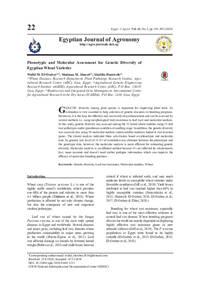Phenotypic and Molecular Assessment for Genetic Diversity of Egyptian Wheat Varieties

Authors:
GENETIC diversity among plant species is important for improving plant traits. Its estimation is very essential to help selection of genetic resources in breeding programs. Moreover, it is the base for effective and successful crop enhancement and can be assessed by several methods i.e. using morphological trait (resistance to leaf rust) and molecular markers. In this study, genetic diversity was assessed among the 53 tested wheat varieties using 15 leaf rust pathotypes under greenhouse condition at seedling stage. In addition, the genetic diversity was assessed also using 10 molecular markers (microsatellite markers) linked to rust resistant genes. The cluster analysis indicated three sub-clusters based on phenotypic and molecular data. In general, low level (r= 0.15) of correlation was obtained between the phenotypic and the genotypic data, however, the molecular analysis is more efficient for estimating genetic diversity. Molecular analysis is an effi cient method because it’s not affected by environment, fast, more accurate and doesn’t need earlier pedigree information which can improve the effi cacy of molecular breeding practices.
